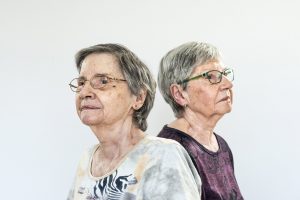The Remaining Dionne Quintuplets, Once The Most Famous Siblings in the World, Want To Keep Their Childhood Home In The Small Canadian Town Where They Grew Up

“Hark The Herald Angles Sing” The Dionne Quintupplets, who have shown marked aptitude for music, delighted in singing Christmas carols with their nurses. They sang in French, of course, for their education in English has not begun. The girls have “singing class” daily. They listen to phonograph records as they lie in bed for the 15-minute rest periods preceding mid-day and evening meals. Front: Annette (l), Emelie. Rear (l to r) : Marie, Cecile, Yvonne. photo: Acme December 26, 1939
The two remaining Dionne Quintuplets have kept a low profile in recent years, but they have come out of their solitude to try and save their childhood home from being moved.
Forget the Kardashians, in comparison to the Dionne’s they would rank obscure. If you are under the age of 50 there is an excellent chance you have never heard of the Dionne quintuplets. But during the 1930s until the early 1940s they were known to everyone, being the most famous siblings in the world.
(UPDATE 4-5-17 – North Bay City Council Reverses Decision To Move Home…For Now)
They were incredibly cute and adorable. And everything they did was photographed, filmed, broadcast and written about.
The identical Dionne sisters were the first known quintuplets to survive infancy. The quintuplets were born May 28, 1934 in a remote village farmhouse in the area of North Bay, near Callendar, Ontario, Canada to poor, uneducated parents Oliva-Edouard and Elzire Dionne. The Dionne’s had five children previously to the quintuplets birth.
As word spread of the incredible event, the quintuplets became media sensations. The public was fascinated by them. That fascination led to incredible exploitation, resulting in a fishbowl existence for Yvonne, Annette, Cécile, Émilie, and Marie Dionne. The quintuplets continually made front page headlines around the world, a needed positive story happening during the depths of the Great Depression. Paraded in front of cameras during their entire childhood, the quintuplets had no knowledge of privacy.
The lack of privacy was because within 4 months of their birth, the Ontario government ruled that the Dionne parents were unfit to take care of the quintuplets. (The government somehow felt the parents could manage the previous five children with no problem.)
Dr. Alan Roy Dafoe who brought the quints into the world was one of the people given guardianship of the sisters.
The Dafoe Hospital and Nursery was built across the road from the quintuplets birthplace. The building was set up for the sisters care, education and everyday needs…and tourist exploitation. The area became known as Quintland.
For nine years the sisters were visited daily by as many as 6,000 visitors per day. Three times per day visitors could view them (for a charge) in an observation gallery. By 1943 it is estimated that over 3 million people had visited them.
This sort of exhibitionism had long term effects on the sisters. The quintuplets did not interact with other children and considered themselves slaves. They were primarily taught English even though their parents spoke French. The sisters enjoyed the lavish life they led but resented the constant observation. Their parents won back custody of the girls in 1943. The quintuplets left the family home in 1952 and became estranged from their parents.
In general the quintuplets did not end up with happy lives.
Marie married and had two daughters, Annette married and had three sons, and Cécile married and bore five children, including one who died in infancy.
Émilie became a nun. Yvonne went to nursing school and ended up becoming a librarian.
Émilie died at the age of 20 as a result of a seizure. At her convent, she rolled onto her stomach and, unable to raise her face from her pillow, accidentally suffocated.
In 1970, Marie, living alone was found in bed, having been dead for days. Her estranged husband claimed she died of a blood clot in her brain.
Annette and Cécile both eventually divorced and by the 1990s, the three surviving sisters lived together in the Montreal suburb of Saint-Bruno-de-Montarville. In 1995 the three sisters claimed their father sexually abused them.
In 1998, the Dionne sisters had reached a $2.8 million settlement with the Ontario government as compensation for their exploitation.
Yvonne who never married, died of cancer in 2001.
Now the surviving sisters, Annette and Cécile are protesting the possible moving of their family home where they were born. The North Bay community had been operating the home as a museum. Now the government plans to move the home to a fairground in Sundridge, a town 45 miles away, that has no connection to the Dionne’s and no provision or funds to maintain it as a museum. It costs around $150,000 a year to run it as a museum and the North Bay community does not have the funds.
Annette told the New York Times this week, “I think the museum staying in North Bay will help to block making foolish choices, like what they did to us, you know,” she said. “And it will never to be repeated again.”
Looking over, Cécile asked her, “You believe in that?”
“Oh, yes.”
“Ah, good for you,” Cécile said firmly, her eyes cast down. “I’m not sure of that.”





